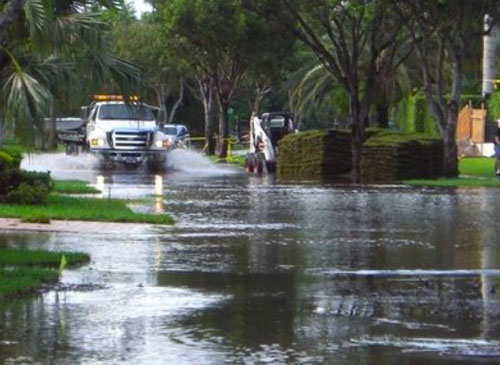But one thing they can’t do is change the weather.
“Insurers believe that due to climate change, this is the new normal. They’re finding that catastrophic and non-catastrophic weather events are increasing in severity every year,” said Paul Handerhan, president of the Federal Association for Insurance Reform, a national nonprofit advocacy organization based in Fort Lauderdale.
The consequences of climate change not only include catastrophic — and increasingly expensive — weather such as hurricanes and wildfires, but also more everyday events such as storms that pelt residential and commercial properties with straight-line wind and hail.
Add in fast population growth in Florida, high demand for high-risk areas such as coastal communities, higher prices for construction and labor, and alleged abuse by contractors who lure policyholders to file inflated damage claims, and you have what one prominent insurance executive calls “total collapse of the overall Florida marketplace.”
The actuarially sound way to respond to the new normal is to raise rates, reduce coverage, or throw in the towel, as eight property insurance companies in Florida have done since 2018. Just this week, three others asked state insurance regulators to approve hefty rate increases — as high as 49 percent on policyholders not among the tens of thousands who recently lost coverage altogether due to non-renewals.
Over time, Handerhan said, property insurance coverage will become so expensive that only the wealthiest of the wealthy can “afford to live in paradise.”
The imminent problem
Job 1 for lawmakers convening in special session next week, said Handerhan, is to secure as much reinsurance coverage as possible for Florida’s remaining insurance companies by June 1, the start of the official hurricane season, 13 days away.
Reinsurers with access to vast capital insure primary insurance companies to cover payouts for catastrophic events that exceed the primary companies’ available funds. Without reinsurance, primary insurers cannot afford to offer coverage in risky areas — which include most of Florida.
“The most pressing, imminent problem is addressing the reinsurance issue,” Handerhan, a 20-year property and casualty executive, said in an interview Thursday.
“That has to be a part of the agenda and that has to be meaningful. They have to provide some comprehensive reforms to provide an ample supply of reinsurance capacity, so these insurers are able to complete their programs and have the reinsurance capacity they need to get them through this hurricane season.”
Handerhan said that means lawmakers must tap billions of dollars in Florida’s Hurricane Catastrophe Fund. The so-called Cat Fund provides reinsurance coverage but likes to be stingy with it to keep a strong surplus on hand in case Florida suffers another Hurricane Andrew (1992) or season of back-to-back hurricanes like the series that clobbered Florida four times in 2004 (Charley, Frances, Ivan, Jeanne).
Citizens Property Insurance Corp., the state’s insurer of last resort, has more than doubled its volume of policyholders in less than two years to absorb customers left stranded when their insurers non-renewed their policies or went out of business. On Wednesday, its board of governors authorized spending $400 million to buy $4.25 billion in reinsurance coverage. That’s nearly double what it needed last year.
“This market is completely,100 percent out of control,” said Barry Gilway, president, CEO, and executive director of Citizens, during the board of governors meeting. “It all has to do with the total collapse of the overall Florida marketplace, and that collapse continues.”
Gilway said the massive growth in the state’s last-resort insurer, caused by the massive drop-off of private coverage, has seriously spooked reinvestors. It would be “an amazing event” if Citizens is able to land even a substantial portion of the $4.25 billion in reinsurance capacity it seeks, he said.
“Were struggling, frankly, to get reinsurers interested, knowing that level of growth, not knowing when it’s going to stop, and how far it’s going to go,” Gilway said. “We’re struggling to find reinsurers that are willing to provide that level of capacity.”
Gilway said the insurance industry is watching closely to see “whether anything relevant” will come out of next week’s special session.
“That will be a determinant, I think, in terms of whether reinsurers in any way, shape, or form reverse their position and release capacity into the marketplace.”
The long view
At the Federal Association for Insurance Reform, Handerhan recommends tapping into the Cat Fund, reducing the state’s “Rapid Cash Buildup Factor” that imposes a 25-percent surcharge on policies to keep the Cat Fund flush with cash, and other measures to “treat the symptoms” of the crisis.
The long view, he said, is that property insurance rates will remain high and get higher as modeling companies, which calculate likely losses in various scenarios for specific areas hit by specific events, improve their accuracy.
These companies increasingly are setting higher and higher estimates on catastrophic and non-catastrophic losses, based on historical data showing the costs of the new normal of severe weather.
But also, as legislators have widely asserted, fraud adds to the escalating losses. Handerhan said the fraud at hand mostly involves roofing contractors who search for “localized” events of severe weather and go there to encourage policyholders to file claims, whether or not it is clear the roof was damaged by the weather event.
“They always find something,” he said. “It’s almost impossible to disprove it.”
Insurance companies in Florida want to stop insuring aging roofs, which would impose financial hardship for low-income and fixed-income residents who may not be able to privately afford to replace their roofs, Handerhan said. That can lead to the mortgage holder “force-placing” insurance on a homeowner’s roof that is two or three times as expensive and only covers the outstanding balance owed to the mortgage company. And that, he said, can lead to foreclosures.
“Fraud is really, truly a problem … and it has a ripple effect, especially for the most vulnerable,” Handerhan said.
“It’s going to get more expensive. People of means can do it. It could become cost-prohibitive for others. T













